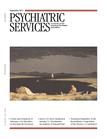Adequacy of Treatment for Patients With Schizophrenia Spectrum Disorders and Affective Disorders in Lombardy, Italy
Abstract
Objective:
This study assessed whether patients being treated for schizophrenia spectrum and affective disorders in Lombardy receive adequate treatment and sought predictors of adequate treatment.
Methods:
Patients were aged ≥18, were residents of Italy's Lombardy region, and were treated in 2007 for schizophrenia spectrum and affective disorders (N=44,462). The patients were assessed as part of a retrospective analysis of pharmaceutical and mental health services databases. Adequacy of 12-month treatment from the first psychiatric contact in 2007 was assessed at the patient level. A hierarchical log-binomial regression model was fitted to estimate relative risk and 95% confidence intervals for association between patients, characteristics of the departments of mental health (DMH), and receipt of minimally adequate treatment.
Results:
About half the patients with serious mental disorders did not receive adequate care; 45.5% of patients with depressive disorders, 55.7% of those with bipolar disorders, and 49.3% of those with schizophrenia spectrum disorders received minimally adequate treatment. Diagnosis of a schizophrenia spectrum disorder or bipolar disorder and male gender predicted adequate treatment, whereas employment and high comorbidity predicted inadequate treatment. Patients who received mental health services in the past year were significantly more likely to receive adequate treatment compared with those who had received services in the past five years or new patients.
Conclusions:
Minimally adequate treatment is a useful indicator to monitor quality of care in Italy's regional mental health system. These data should be used at regional and local levels to implement clinical audits, to create benchmark measures, and to define new quality-improvement projects to meet specific DMH needs. (Psychiatric Services 62:1079–1084, 2011)



